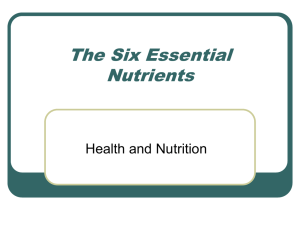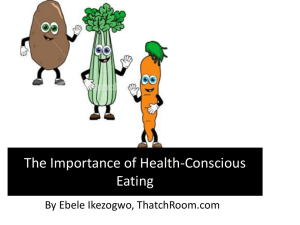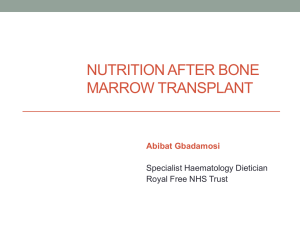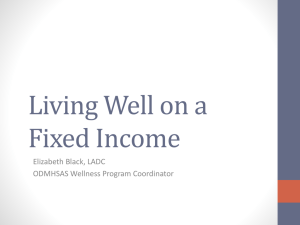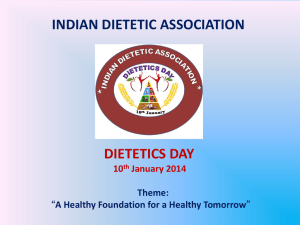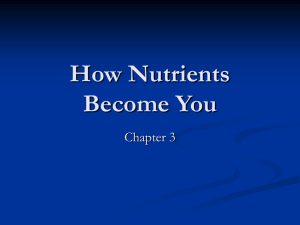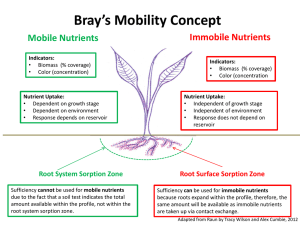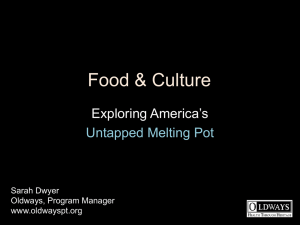Chapter 10 Nutrition
advertisement
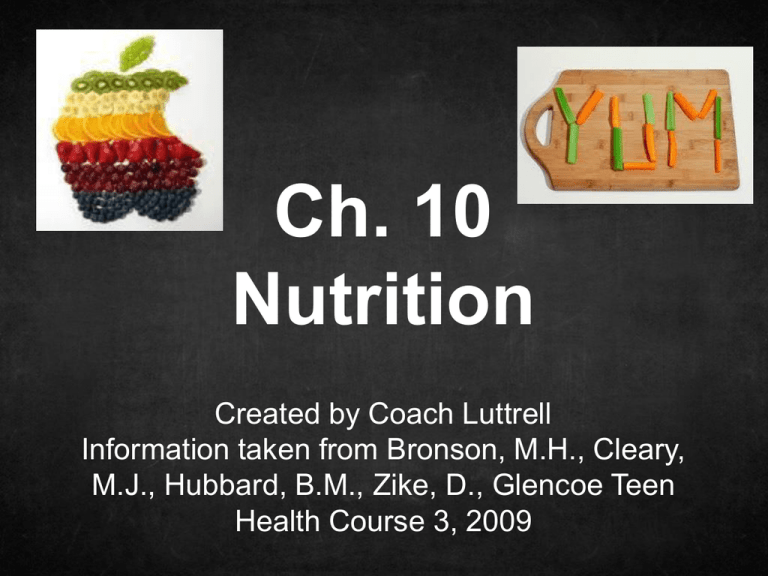
Ch. 10 Nutrition Created by Coach Luttrell Information taken from Bronson, M.H., Cleary, M.J., Hubbard, B.M., Zike, D., Glencoe Teen Health Course 3, 2009 Lesson 1: The Importance of Nutrition Objectives: • The student will be able to explain why the body needs nutrients. • The student will be able to identify factors that influence which foods you chose. • The student will be able to describe how your emotions can affect your food choice. Vocab Words (4): Nutrients, Nutrition, Appetite, Hunger. The Role of Food • Food is a necessity in life, like water and air. • Your food choices affect all 3 sides of your health triangle. • Ex. not eating breakfast. • Physical- Low on energy • Men/Emo- Trouble focusing • Social- Grumpy and irritable Food, Nutrients and Nutrition • Nutrients: are substances in food that your body needs. • They help build new tissue, repair damaged cells and produce energy. • Nutrients nourish the body in two ways: • 1) They provide energy (proteins, carbohydrates, and fats) • 2) They help your body run smoothly (vitamins, minerals, and water). • Nutrition: the study of nutrients and how the body uses them. What Influences Food Choices? • • • • Peer Pressure Availability Convenience Knowledge of Nutrition • Advertising • Family and Culture Appetite and Hunger • Appetite: the psychological desire for food. • Smells or memories might make you crave food even though you do not need it. • Hunger: the body's physical need for food. • It is important to learn the difference between appetite and hunger so you can make healthy food choices. Food and Emotions • Emotions can also influence the way we eat. • If someone is feeling sad or stressed out they might turn to food to feel better. • Remember to deal with your feelings and emotions in healthy ways. (journalling, talking with a friend, exercising) Meeting Nutrient Needs • All bodies need the same nutrients, but not the same amount. (ex. Size, Age, Energy level) • Teens vs Adults, Olympians vs Average Joes • Most people in the US get enough food to eat but don't get the nutrients they need. This is because of foods that are high in fat and added sugar. • Eating low-nutrient foods, along with overeating can lead to obesity, heart disease and cancer. Ch. 10 Lesson 1 Questions 1. Define appetite and explain how it can affect which foods you choose to eat. 2. What do nutrients do for your body? 3. What role do emotions play in your food choices? 4. Which factors do you think influence a teen's food choices most? Explain your answer. 5. How is it possible to have plenty of food and yet be poorly nourished? Lesson 2: Nutrients for Wellness Objectives: • The student will be able to identify the six major classes of nutrients. • The student will be able to explain specific ways your body uses nutrients. Vocab Words (7): Carbohydrates, Fiber, Proteins, Saturated Fats, Unsaturated Fats, Vitamins, Minerals Nutrients and Nutrition • Scientists have found more than 40 different kinds of nutrients. • The six main categories of nutrients are: 1. 2. 3. 4. 5. 6. Carbohydrates Proteins Fats Vitamins Minerals Water • Eating a variety of healthy foods will help you get the nutrients you need. Carbohydrates • Carbohydrates: sugars and starches that occur naturally in foods, mainly in plants. • Made up of sugar molecules • The body's main source of energy • Nutritionists suggest that 45%-65% of daily energy should come from carbs. Simple vs. Complex Carbohydrates Two types of carbs: 1. When molecules stay separate it forms simple carbs. 2. When molecules join together they form long chains called starches or complex carbs. Fiber • Fiber: is the parts of fruits, vegetables, grains and beans that your body cannot digest. • As fiber moves through the digestive system it pushes other food particles along. • Eating high-fiber foods can help reduce certain types of cancers and heart disease. Proteins • • • • • Proteins: are nutrients your body uses to build, repair and maintain cells and tissues. They are made up of chemical building blocks called amino acids. Muscles repair themselves and build new tissue after a workout. Proteins also help fight sickness and disease because parts of our immune system are made of proteins. Complete proteins contain all 9 essential amino acids. Examples are animal base products. Fats • Saturated Fats: are fats that are solid at room temperature. • Ex, Butter, cheese, and fatty meats. • Eating too many saturated fats increase your risk of heart disease. • Unsaturated Fats: are fats that are liquid at room temperature. • Ex, Olive oil, nuts, and avocados • Promote healthy skin and normal cell growth and they carry vitamins to where they are needed in the body. Cholesterol • Cholesterol is both a fatlike substance found in food and a fatty substance in the blood. • Cholesterol in food only comes from animal-based foods like eggs, meat, poultry, fish and dairy products. • Eating too much food cholesterol can raise blood cholesterol, clog arteries and lead to heart disease. Vitamins & Minerals • Vitamins: substances that help your body fight infections and use other nutrients, among other jobs. • Minerals: elements that help form healthy bones, teeth and regulate certain body processes. There are two categories of vitamins: 1. Water-Soluble dissolve in water and your body cannot store them. Ex: Vitamin C and B Complex 2. Fat-Soluble are stored in the body until needed. Ex: Vitamin A, D, E & K. Vitamins & Minerals Sources from food Functions in the body • • • • • • • • • • Vitamin A- healthy skin and vision B Vitamins- healthy nervous system, produce and maintain new cells. Vitamin C- healthy teeth, gums and bones. Helps health wound and fight infection. Vitamin D- strong bones and teeth, helps absorbs calcium. Vitamin E- helps protect cells. Calcium- build and maintain strong bones and teeth. Fluoride- strong bones and teeth, prevents tooth decay. Iron- Hemoglobin in blood cells. Magnesium- strong bones; releases energy for muscles. Potassium- regulate fluid balance in tissues; promotes proper nerve function. • • • • • • • • • • Dark leafy greens; dairy products; eggs; yellow-orange fruits and vegetables. Poultry; eggs; meat; fish; whole-grain breads Citrus fruits; strawberries; mangoes; tomatoes; broccoli; potatoes Milk; salmon; egg yolks; liver Dark leafy greens; fish; nuts; seeds; vegetable oils. Dairy products; dark leafy greens; canned fish with edible bones. Fluorinated water; fish with edible bones. Red meat; poultry; dry beans; nuts; eggs; dried fruits; dark leafy greens. Dark leafy greens; beans and peas; whole-grain breads and cereals. Bananas; oranges; dry beans and peas; tomato juice. Water • • • • • • • • • Plays a role in body functions Helps you digest and absorb food Regulates body temperature and blood circulation. Carries nutrients and oxygen to cells. Dehydration, or lack of water in your body, can cause problems. Fatigue, confusion and trouble focusing. You should drink between six and eight 8 oz. glasses of fluid a day. Even more fluid is needed during activity or hot weather. Choose milk or water and limit intake of juice and soda "If it were possible to drain all the water from a 160 lb. man, his dehydrated body would weigh only 64 lbs."~Bethesda Health & Fitness Center Ch.10 Lesson 2 Questions 1. What is fiber? What function does it have in the body? 2. What are the six major classes of nutrients? 3. What are some sources of complete proteins? 4. Make a list of the foods you have eaten today. Identify which nutrients can be found in each food. Are there any nutrient groups that you should have eaten more of? 5. How can the food you eat today affect your health in the future? Lesson 3: Following Nutrition Guidelines Objectives: • The student will be able to explain how to use the MyPyramid food guidance system. • The student will be able to identify the names of the five main food groups. • The student will be able to describe recommendations from the Dietary Guidelines for Americans. Vocab Words (4): MyPyramid food guidance system, Calorie, Sodium, Foodborne illness Guidelines for Healthy Eating • MyPyramid Food Guidance System: is a system designed to help Americans make healthful food choices. • Created by the United States Department of Agriculture (USDA). • The pyramid is divided into six sections: • The 5 main food groups (grains, vegetables, fruits, dairy, meat/beans) • The 6th section represents fats and oils. • It also has a figure walking up steps to show that you need exercise everyday to stay healthy. USDA replaced the MyPyramid in 2011 with Choose My Plate http://www.choosemyplate.gov/ Other Guidelines for Good Health • Eat a variety of foods, so you get all the nutrients your body needs. • Eat more fruits, vegetables and whole grains. • 1/2 the grains you eat a day should be whole grains. • Balance the calories you consume with physical activity. • Calorie: a unit of heat that measures the energy available in food. • A normal teen needs about 2,000 calories a day. If you play a sport or are very active you might need more calories in your diet. • Eating more calories than you can burn off can lead to gaining more weight than is healthy for your body. • Teens should be physically active for at least 60 minutes each day. Exercise helps to burn calories and help you stay healthy. Guidelines for Health (Cont.) • Limit fats, sugar and salt. • Many processed foods contain hidden fats. • Don't eat sweets everyday. • Sodium: a nutrient that helps control the amount of fluid in your body. • Found in salt. • Too much can cause high blood pressure. Nutrition Labels • Learning how to read nutrition labels can help you make healthy food choices. • Start with Serving Sizes • Then check calories • Limit these • Get enough of these • Quick guide to % of Daily Value: • 5% is low and 20% is high. • Bottom footnotes Keep Foods Safe to Eat • Foods must be handled and prepared properly. • If not they can become contaminated with bacteria. • Foodborne Illness: a sickness resulting from eating food that is not safe to eat. • Ways to keep food safe: 1. Wash hands with hot soapy water before handling food. 2. Make sure foods are cooked and stored at the right temperatures. 3. Use separate cutting boards and knives when cutting raw meat Ch.10 Lesson 3 Questions 1. Who created the MyPyramid food guidance system and what is its purpose? 2. What are the five main food groups in MyPyramid? What does the sixth group represent? 3. What are two things you can do to keep your foods safe from harmful bacteria? 4. Explain what MyPyramid is designed to help you know about which foods to eat. 5. Tom had a peanut butter sandwich and a glass of milk for lunch. Which food groups do these foods represent? What else could Tom eat to add more food groups to his lunch? Lesson 4: Planning Meals & Snacks Objectives: • The student will be able to explain why breakfast is important. • The student will be able to describe mealplanning tips. • The student will be able to identify healthy ways to snack. Vocab Words (2): Empty-calorie foods, Nutrient density Planning Healthy Meals Three key words: 1. Variety- helps make meals more nutritious and interesting 2. Moderation- portion size and limiting fats, sugars and salt can help lower your risk of certain diseases 3. Balance- Calories in with calories out. Use exercise to help fight weight gain. Breakfast • Breakfast has been called the most important meal of the day. • After sleeping all night your body needs to reboot itself. • Eating breakfast helps: 1. Get your body going. 2. Provides fuel to last until lunch. 3. Staying alert and focused. • Round out your meal with a cup of fruit and a glass of milk. • Watch for added sugars in trail mixes, breakfast bars and toaster pastries. • Ex. Honey, sugar, molasses and high fructose corn syrup. Lunch & Dinner • Eat 4 or 5 smaller meals throughout the day vs. 3 big meals. • Helps keep metabolism steady. • Vary proteins- 5-7 1oz. servings of protein a day • Empty-calorie foods: foods that offer few, if any, nutrients but do supply calories. • Watch fats, sugar & salt • Keep a food journal so you don't get too much or too little of anything • Exercise and stay active Snacking Smart • Snacking can help meet nutritional needs and also help us make it to the next meal. • Make healthy choices when you snack. • Don't eat absent mindedly • Don't eat out of the container • Don't eat right before a meal • Nutrient density: is the amount of nutrients relative to the number of calories they provide. Eating Out, Eating Right There are ways to eat healthy even when you eat at a restaurant: • Choose an appetizer for your meal • Take half of your meal home for later • Split a dish with someone • Check for heart healthy or low calories options • Chose foods that are grilled, broiled or roasted instead of fried • Ask for sauces and dressings on the side Ch.10 Lesson 4 Questions 1. What makes a food an empty-calorie food? 2. Why is breakfast important? 3. What are three meal-planning tips that allow variety, moderation and balance to your eating plan? 4. How can you avoid overeating when you eat at a restaurant? 5. You are hungry, but dinner is still an hour away. What is a snack that would help you feel less hungry but still leave you ready to eat dinner? How much of the snack do you think you should eat? Extras
